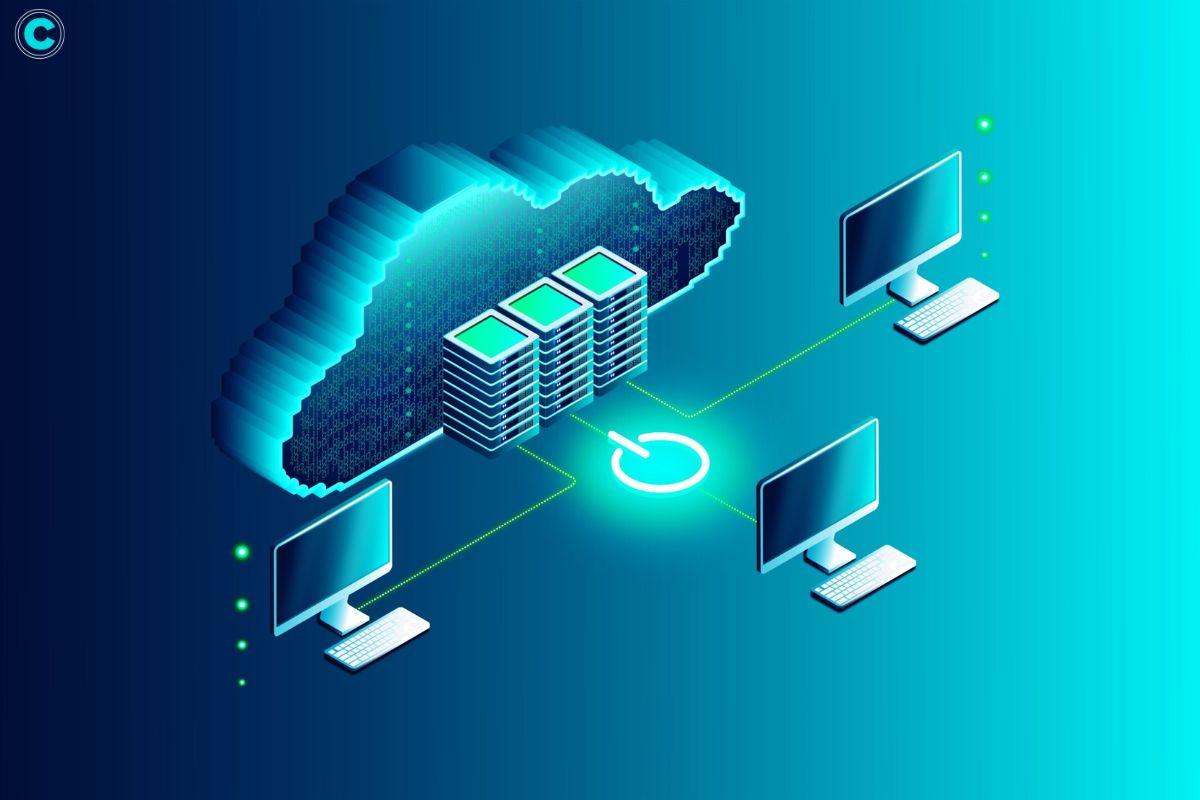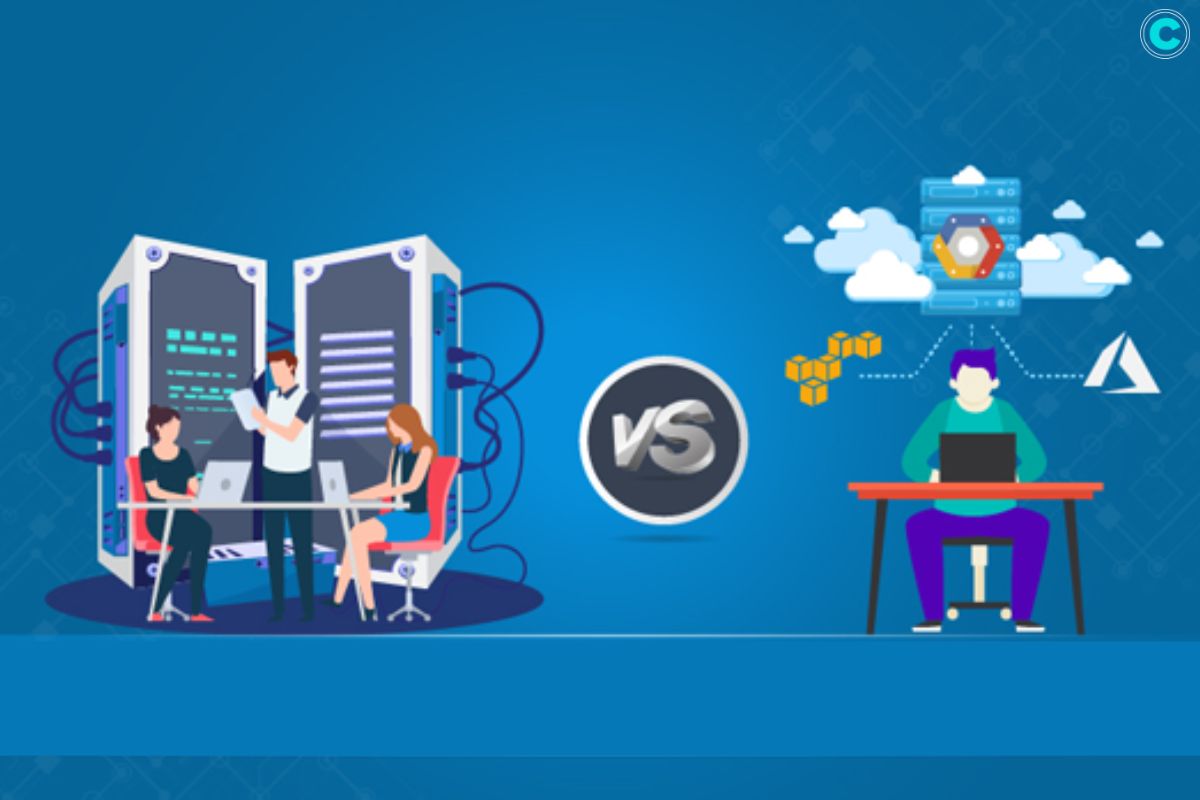(Source – Medium)
In today’s digital world, businesses have a big decision to make: should they go for cloud computing or stick with on-premise solutions? Both options have their pros and cons, so it’s important for organizations to think it through. In this article, we’ll break down the differences between cloud computing and on-premise solutions, helping you make the right choice for your business. So let’s dive in and get you informed!
Cloud Computing vs On-Premise: Understanding the Basics
Cloud computing vs on-premise solutions are two different approaches to managing and delivering computing services within an organization. Let’s dive deeper into each of these concepts:
Cloud Computing:
Cloud computing refers to the delivery of computing services over the internet, commonly known as “the cloud.” It involves accessing and utilizing various resources, such as storage, servers, databases, networking, software, and more, from a cloud service provider
Here are some key points to understand about cloud computing:
1. Service Models:
Cloud computing offers different service models, including Infrastructure as a Service (IaaS), Platform as a Service (PaaS), and Software as a Service (SaaS)
- IaaS provides on-demand access to computing infrastructure, such as servers, storage, and networking resources, which customers can provision and use similar to on-premise hardware. However, the cloud service provider hosts, manages, and maintains the hardware and computing resources in its own data centers.
- PaaS offers an on-demand environment for developing, testing, delivering, and managing software applications. It provides a platform for developers to build and deploy applications without worrying about the underlying infrastructure.
- SaaS delivers software applications over the internet on a subscription basis. Users can access and use these applications without the need for installation or maintenance on their local devices.
2. Scalability and Flexibility:

Cloud computing provides organizations with the ability to scale resources up or down based on their needs. This scalability allows businesses to handle fluctuations in demand and avoid overprovisioning or underutilization of resources.
3. Cost Efficiency:
Cloud computing often follows a pay-as-you-go model, where organizations only pay for the resources they use. This can be more cost-effective compared to on-premise solutions, as it eliminates the need for upfront investments in hardware and software.
4. Accessibility:
Cloud computing enables users to access their applications and data from anywhere with an internet connection. This flexibility allows for remote work, collaboration, and easy access to resources on various devices.
On-Premise Solutions:
On-premise solutions involve housing all hardware, software, servers, and infrastructure within the premises of the organization. These resources are managed and maintained by internal IT staff.
Here are some key points to understand about on-premise solutions:
1. Control and Security:
On-premise solutions provide organizations with greater control and visibility over their infrastructure. Since the infrastructure resides within the company’s data center, IT teams have direct management and control over the resources.
2. Customization:
On-premise solutions allow for greater customization and flexibility in terms of hardware and software choices. Organizations can tailor their infrastructure to meet specific requirements and integrate it with existing systems.
3. Data Privacy:

With on-premise solutions, organizations have complete ownership and control over their data. This can be important for industries with strict data privacy and compliance regulations.
4. Upfront Costs:
On-premise solutions typically require significant upfront investments in hardware, software licenses, and infrastructure setup. Organizations need to purchase and maintain their own servers, storage, and networking equipment.
Choosing the Right Approach:
When deciding between cloud computing vs on-premise solutions, organizations need to consider their specific IT needs, budget, scalability requirements, data privacy concerns, and the level of control they require over their infrastructure. Some organizations may choose to adopt a hybrid approach, where they utilize a combination of cloud and on-premise solutions to meet their unique requirements.
It’s important to note that the choice between cloud computing and on-premise solutions is not always binary. Organizations can also consider other factors such as security, compliance, and the complexity of their IT infrastructure when making this decision.
Overall, cloud computing offers scalability, flexibility, and cost efficiency, while on-premise solutions provide greater control, customization, and data privacy. The choice between cloud computing vs on-premise depends on the specific needs and priorities of each organization.
Advantages of Cloud Computing vs On-Premise
- Scalability: Cloud computing offers unparalleled scalability, allowing businesses to easily scale up or down their resources based on demand. This flexibility ensures efficient resource utilization and cost-effectiveness.
- Cost-Efficiency: With cloud computing, businesses can avoid substantial upfront investments in hardware and infrastructure. Instead, they pay for the resources they use on a subscription basis, resulting in predictable monthly expenses.
- Accessibility: Cloud computing enables employees to access data and applications from anywhere with an internet connection, promoting remote work and collaboration. This accessibility enhances productivity and flexibility within the organization.
- Automatic Updates and Maintenance: Cloud service providers handle updates, patches, and maintenance tasks, relieving businesses of the burden of managing these tasks internally. This ensures that organizations always have access to the latest features and security enhancements.
- Disaster Recovery and Backup: Cloud computing providers offer robust disaster recovery and backup solutions, ensuring data integrity and business continuity in the event of a disaster or system failure.
Advantages of On-Premise Solutions vs Cloud Computing

- Control and Customization: On-premise solutions provide businesses with complete control over their infrastructure and environment. This level of control allows for customization to meet specific business requirements and regulatory compliance needs.
- Security and Compliance: Some businesses, particularly those operating in highly regulated industries, may prefer the enhanced security and compliance offered by on-premise solutions. With data stored on-site, businesses have greater visibility and control over security measures.
- Predictable Performance: On-premise solutions can offer predictable performance levels, as resources are dedicated solely to the organization. This can be advantageous for businesses with stringent performance requirements or sensitive workloads.
- Data Sovereignty: For businesses operating in regions with strict data sovereignty laws, on-premise solutions may be preferred to ensure that data remains within the jurisdiction and under the control of the organization.
- One-time Cost: While cloud computing involves ongoing subscription fees, on-premise solutions typically require a one-time upfront investment in hardware and infrastructure. For businesses with long-term financial planning considerations, this may be advantageous.
FAQs on Cloud Computing vs On-Premise
1. Is cloud computing more cost-effective than on-premise solutions?
While cloud computing eliminates upfront hardware costs and offers pay-as-you-go pricing, on-premise solutions may be more cost-effective over the long term for some businesses, particularly those with predictable workloads and stringent security requirements.
2. Is cloud computing less secure than on-premise solutions?
Cloud computing providers invest heavily in security measures, often offering advanced encryption, access controls, and compliance certifications. However, some businesses may still prefer the enhanced control and visibility offered by on-premise solutions for sensitive data.
3. Can I switch from on-premise to cloud computing or vice versa?
Yes, businesses can migrate between on-premise and cloud computing environments, although the process may vary in complexity depending on factors such as data volume, application compatibility, and regulatory requirements.
4. What factors should I consider when choosing between cloud computing vs on-premise solutions?
Key factors to consider include scalability needs, budget constraints, security and compliance requirements, data sovereignty concerns, and the level of control and customization desired by the organization.
5. Can I use a hybrid approach combining both cloud computing and on-premise solutions?
Yes, many businesses opt for a hybrid approach, leveraging both cloud computing and on-premise solutions to meet their specific needs. This approach allows businesses to enjoy the benefits of both deployment models while addressing unique challenges and requirements.

Safeguarding Your Data: A Comprehensive Guide to Cloud Computing Security
In the modern world, businesses are turning to cloud computing to handle their data. It’s like having a virtual storage space that can do a lot of things. Cloud computing is popular because
Conclusion:
The decision between cloud computing vs on-premise depends on various factors, including business goals, budget constraints, security requirements, and regulatory compliance needs. By understanding the advantages and considerations associated with each option, businesses can make informed decisions that align with their objectives and support their long-term success.






